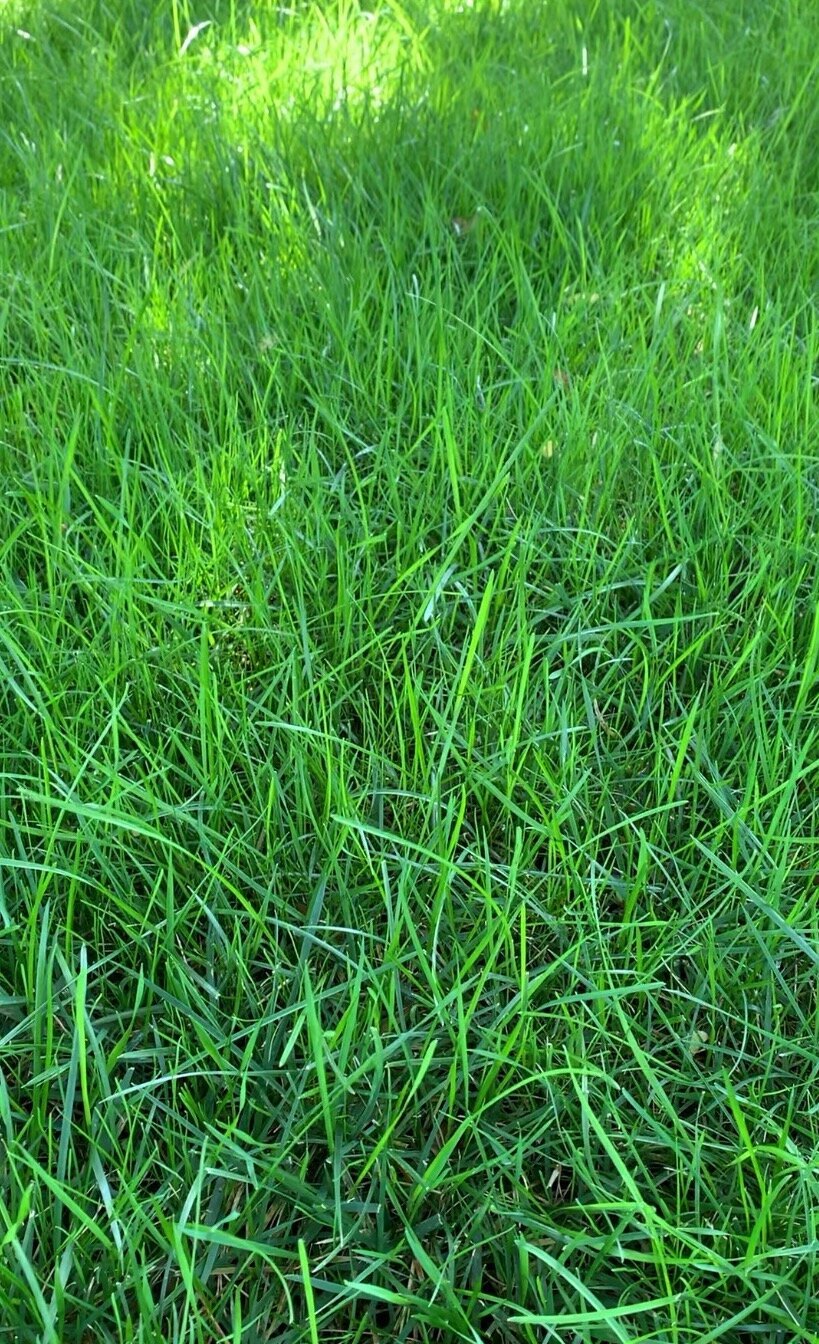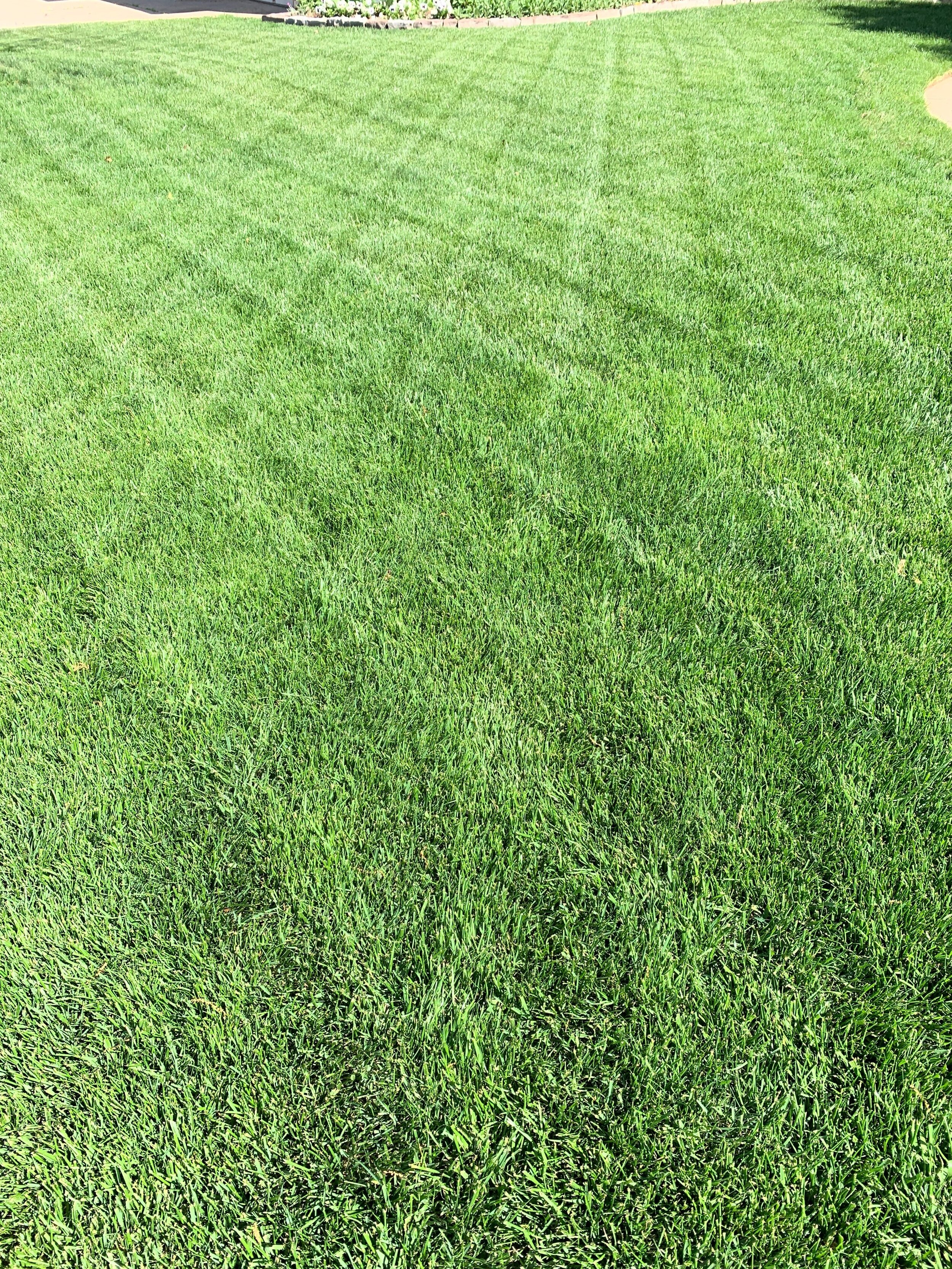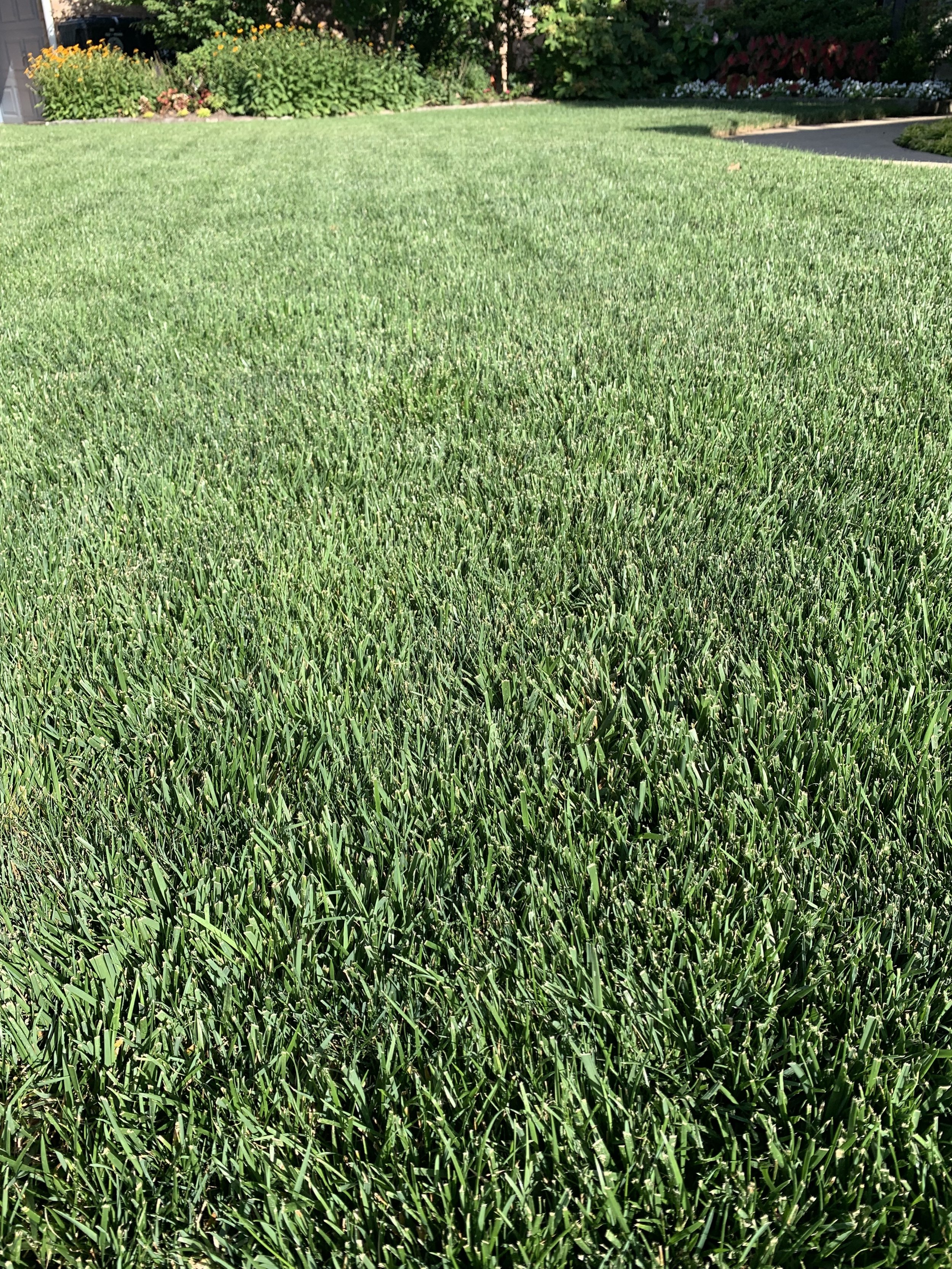
Aeration… the "Then Some” of Lawn Care
A good lawn is the result of several key activities:
1. Correctly timed pre-emergent applications to prevent weeds before they germinate.
2. Applying the right amount of fertilizer to ensure you have a thick and healthy turf.
3. Regularly scheduled mowing that only removes the top 1/3 of the leaf blade each time.
4. Infrequent, deep watering based on seasonal need.
But, there is a 5th activity that too often is overlooked.
George Toma, the greatest groundskeeper in the history of sports, has a saying:
“Do the job and then some. It is the ‘then some’ that
distinguishes the mediocre from the great.”
George Toma played a part in preparing the playing field for every Super Bowl until he retired after Super Bowl LVII at the age of 95. Toma is known as “The Sodfather!”
George Toma, presenting the keynote address at a turf conference several years ago, started his talk by announcing he was going to discuss the three most important things to have a great turf.
His 1st point was Aeration.
His 2nd point was Aeration.
And, you guessed it, his 3rd point was Aeration.
What are the benefits of aeration?
Soil compaction is reduced.
Air movement into the soil is improved.
Fertilizer can quickly reach the root zone.
Water runoff and puddling is reduced.
Roots grow stronger and deeper.
Thatch is reduced.
Reduction in weeds that thrive in compacted soils.
For George Toma, the “then some” that distinguishes the mediocre lawn from a great lawn is aeration.
Aerification is a must!
If your goal is to have your best lawn possible, aeration is a required step in your lawn care program.
What is aeration?
Aeration is the process of mechanically removing 2”-3” cores of soil, 4”-6” apart, from your lawn.
Compact soils prevent grass from establishing a healthy root system and prevent air, water, and nutrients from reaching the root zone. Walking, playing, and mowing (in other words everything you do on your lawn) increases soil compaction.
As Oklahomans, we know about tight clay, compacted soils. Our clay soils make growing a great lawn a challenge.
Too often we accept soil compaction as just the way it is and settle for the status quo of an average lawn.
Stop accepting the norm!
You don’t have to struggle with the results of growing a lawn in tight, compacted soil.
Golf courses typically aerate their turf at least two times per season. No wonder the fairways look so much better than most home lawns.
Lawns with compacted soil also are more susceptible to weed development. Most weeds thrive in tight compacted soil.
Nutsedge, one of the most difficult to control summer weeds, thrives in tight soils. Our experience has shown that annually aerated lawns have far less problems with nutsedge.
Why do golf course fairways always look so good? Turf managers know the importance of aeration. The secret to a great lawn is a great root system. Annual aeration is the ticket to a great root system.
Should the cores be removed or left on the lawn?
Leave the cores on the lawn. As they breakdown and dissolve, they will refill the holes with loose soil resulting in improved soil structure. The cores will break up and settle back into the lawn within a few weeks.
When should you aerate?
Warm season lawns (Bermuda and zoysia) should be aerated any time after spring green-up and before the end of July.
Cool season lawns (fescue) should be aerated in the fall, September through October. Aeration in conjunction with overseeding will not only improve the soil structure, but it will also improve seed soil contact resulting in better seed germination.
Now through the first half of the summer growing season is the best time to aerated lawn Bermuda, a warm season turf.
Nothing will take your lawn from good to great more than an annual aeration!
One more Toma saying… “The most important part of grass is the soil and the root system.”
Aeration is the best way to improve the soil structure and develop a stronger root system.
Aeration, the most overlooked lawn practice, will give you a healthier, more vigorous, less weedy lawn.
To achieve your best lawn, annual aeration is a must.
Lorne Hall
Hall | Stewart Lawn + Landscape
(405)367-3873
May Lawn & Landscape Tips
May is an easy month to love. Days in the 80’s… Green, green lawns… Landscapes full of bright colors!
May, a month made for being outside in your lawn and landscape!
May is a busy month for the lawn and landscape.
Here are a some of the most important outdoor tasks to focus on:
Crape Myrtles started putting on new growth this year. Now is the time to inspect and prune out any dead wood.
If you are unsure if the branch is dead, scratch the bark. If the layer just below the bark is green, then the branch is alive.
Turf Fertilizer – Bermuda lawns need a good feeding between late April and the end of May. Bermuda will respond well to a balanced fertilizer with at least 28% to 30% nitrogen and only a small amount of phosphorus and potassium. Fescue turf needs to receive one more application of fertilizer between mid-April and mid-May to get them ready for warm days of summer. Once temperatures consistently reach 90 fertilizing fescue will do more harm than good.
Weed Control - Weeds that were not prevented, both grassy and broadleaf weeds, require additional treatment to control. Now that warm season turf is out of dormancy, control of weeds can be stepped up. During May it is best to spot spray any persistent perennial weeds being careful to limit turf damage. Remember the absolute best weed control is thick and healthy turf.
Nutsedge has begun to show up in lawns. Because there isn’t a way to prevent nutsedge, spot treatments can be expected. If nutsedge has been a chronic problem in your lawn, annual aeration will make a difference. Nutsedge thrives in tight, wet soils and since aeration reduces compaction, we find yards that are aerated annually have less nutsedge issues.
Nutsedge
Maynight Salvia, the perfect name for the perennial that adds bright blues and purples to the May landscape.
Anytime we make an application of weed control or fertilizer, please let us know if you have any concerns 10-14 days after our visit. If the turf isn’t greening up properly, or if weeds are not wilting, we want to know. If you are new to our program, we know it will take time to get your lawn to the healthy condition you desire. But we expect to make progress with each visit. We know this may require additional visits and if you are on our full 7- Step Program, we will make the needed extra visits.
Oakleaf Hydrangeas will start gracing the landscape with their white blooms this month.
Tree & Shrub Care – We subscribe to an integrated pest management approach, which starts with inspecting trees and shrubs and treating as needed. Starting in May and continuing through the growing season, take a few minutes each week to inspect your landscape for insects and disease.
Spider Mites – When it comes to Insect and Disease you always have to be on the lookout. Typically, we are on the watch for spider mites, the Twospotted Spider Mite, in the summer when conditions are hot and dry. But there is also the Spruce Spider Mite that is active in the spring and fall. They can be found on spruce, pines, junipers and arborvitae. It can cause considerable damage early in the season before we are even thinking about spider mites. The first indication of the Spruce Spider Mite damage is off-green color needles. Spider mites are not controlled by normal insecticides. If trying to control them yourself, you must use a product labeled as a miticide. Insecticides will not control spider mites.
The first indication of Spruce Spider Mite damage is an off-green color on your spruce, pine, juniper or arborvitae.
Bagworms - May is the month to be watching for bagworms on needle evergreens. Bagworms are quite easy to control when they are small. But they are very hard to see when they first start to develop. If you notice bagworms, or have a concern about your plants, please let us know.
Bagworms
Spider mites are small and almost impossible to see on the plant. If you are concerned you have spider mites, shake the plant over a white sheet of paper. If the little specks start moving they are spider mites.
Be on the lookout for bagworms this month. They are much easier to control when they are small.
Leaf spot
Leaf Spot - Leaf spots will develop if we have periods of sufficient moisture and temperatures are just right for development of the fungus. The best host for leaf spot is an already unhealthy plant in an area with poor air circulation. Control includes spraying with a fungicide at least two times in a 10–14-day period, keeping fallen leaves picked up and disposed of, and thinning the tree or shrub to improve air flow.
Aphids – A small insect that isn’t easy to spot, but the honeydew, sticky substance they excrete is easy to spot. Aphids develop on the underside of leaves, often reaching large populations before you notice them. Early detection is important, and if caught early, a high-pressure blast of water may do the trick. As the weather warms, populations increase, and insecticide treatment will be needed.
Lawn Maintenance – Both warm and cool season turf grasses need frequent mowing now. One of the most important things for good turf health is to avoid removing more than 1/3 of the grass in one mowing. Not only does it not yield you the best-looking lawn when you cut below the leaf and into the stem of the grass, it also weakens the root system. Try to maintain your Bermuda on the middle setting or just below the middle setting in May. For fescue, raise the setting one notch this month and cut the lawn 2.5-3” tall. By early June it is best to have fescue at a maximum height going into the summer.
When mowing frequently, only remove 1/3 of the grass, don’t bag the clippings. Mulch them back onto the lawn. Grass leaf blades are mostly nitrogen and water and are very beneficial to the lawn.
Dianthus is a perennial that graces the May landscape with vibrant blooms and gray and green foliage.
May Night Salvia, Dianthus and Gold Moneywort make a colorful combination in the May landscape.
Full sun planting of lantana, penta, angelonia, and sunpatiens.
Sun Coleus
Fescue color is at its best this month.
Lantana and Sun Coleus make a great summer combination in full sun, hot areas. May is the month to plant them.
Seasonal Color – May is the month to plant your summer annual color. Most landscapes look best with a splash of bright color creating a welcoming environment near the front door. Impatiens and Caladiums are great choices for full shade areas. Begonias, petunias, and geraniums do well in sun to part shade. And for full sun, periwinkle, lantana, sunpatiens, angelonia, sun coleus and penta are good at handling the heat.
Penta
Caladium
Take into consideration the mature size when planting seasonal color. The temptation is to over plant.
Irrigation – As of Saturday morning the Oklahoma City Metro area has only received 1.5” of rain. In a typical April we receive 3.5-4”. With less than normal rainfall has caught many off guard as we are seeing a lot of lawns suffer from early signs of draught stress, which is not a common condition for this time of year. With your lawn now needing 1” of moisture per week, it is time to start your normal watering routine. But remember - the best irrigation management is one that includes keeping an eye on rainfall amounts, soil moisture, and temperatures. Monitor conditions, turn your system off if when are in a rainy period. Poor water management is setting the irrigation system at the beginning of the season and letting it run regardless of the conditions.
If you have subscribed to our Irrigation Management program with the Rainbird Wi-Fi Link, we will make watering decisions based on soil temperatures, soil moisture, temperatures, and recent rainfall and adjust your controller via the Rainbird app.
Azalea Care – Azaleas were stunning this spring. Azaleas require a little more care, but they are worth it. Fertilize azaleas this month. After blooms fade and before the end of June prune azaleas if needed. Pruning after mid-summer will result in less blooms next year. Azaleas look best when minimally pruned and allowed to retain their natural shape. Prune by removing longer shoots by reaching down and making cuts where they come off a larger branch. This will improve air moment and promote healthy growth. Avoid shearing azaleas. Add a fresh layer of mulch to keep the soil cooler and retain moisture during the warm summer months to come. The best mulch for azaleas is pecan hulls or pine bark.
Peonies have been adding a burst of color to the landscapes for the last two weeks.
The same plantings in July
Wisteria
Periwinkle
Remove the brown stems on your hydrangeas left from the winter back to the first bud this mont.
Hydrangea Pruning – If you haven’t already, now is the time to prune the brown stems left from the winter back to the first bud. In most cases this is the only pruning recommended for hydrangeas. During the summer, if you want to you can snip off spent blooms, but it is not required. Otherwise, keep the pruners and shears away from your hydrangeas. And…never prune in the fall.
Gold Mound Spirea not only add interest to the landscape with their foliage, they also deliver an additional touch of color with red-violet blooms this month.
If you have any questions, please drop us an email or give us a call at (405)367-3873.
Our mission is to help you have your best lawn and landscape…one that improves the appearance, enjoyment and value of your surroundings.
Lorne Hall
Hall | Stewart Lawn + Landscape
(405)367-3873













































